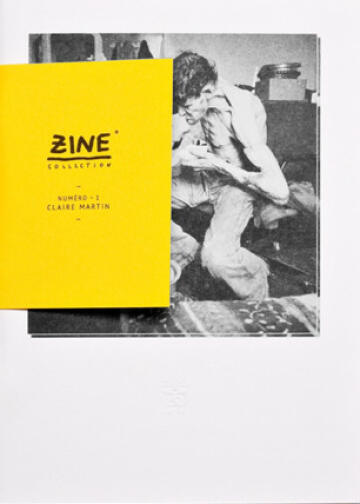Zine Collection N°1: The Downtown East (signed+print)
by Claire Martin
Photographs: Claire Martin
Publisher: Edition Bessard
40 pages
Year: 2012
Comments: A limited edition of 100 copies, signed print
During my time in Vancouver, Canada, I decided to pursue a personal photographic project documenting the lives of residents in the Downtown East Side. Having started my career studying Social Work, this suburb of Vancouver was instantly of interest to me because it is a microcosm of visible social ills. These include but are not limited to: extreme poverty, homelessness, addiction, prostitution and an AIDS rate estimated at over 30%.
A study by “The Tyee” concluded that the DTES has North America’s fastest growing homelessness crisis. This is the result of a myriad of problems. Most prominently there is gentrification of the DTES due to its close proximity to the Downtown core and development for the 2010 Olympics. Warmer weather than much of Canada draws the homeless, teen run-aways and vagrants to the area where it is more comfortable to survive on the street. Additionally, a relaxed policy on drugs has created tolerance for an open-air drug market making the area a destination place for addicts and homeless people desiring easy access to cheap drugs. Addiction is surely the most obvious problem in the DTES. According to the PIVOT legal Society in Vancouver there are over 5000 injection drug users living in the ten-block radius. The leading cause of death is overdose and 1/3 of the population is addicted to illicit drugs. This high rate of addiction contributes to the area’s incredibly high crime rate. The government is experimenting with harm reduction techniques and new ways of thinking, such as dealing with addiction as a public health issue rather than a criminal one. A safe injection site (the only one in North America) is one such technique in practice in the DTES. With an AIDS rate at 35%, rivalling that of Botswana, it is obvious that we need to start thinking outside the square. Needle exchange programmes have proven to be an effective tool for reducing the spread of HIV, although it is commonly women who sell sex in order to meet subsistence needs such as food and shelter that are affected by this horrific disease. Hepatitis C is recorded at 90% of the population of the DTES. The media regularly makes rounds of the DTES, but it only serves to stigmatise the people. It is easy to forget that this is a real suburb and home to real people, who are suffering devastating loss of health and quality of life.
A formal complaint regarding conditions in the DTES has been put forward to the United Nations by Michael Byers, a University of British Columbia professor. The United Nations Human Rights Council is expected to take two years to hear and study the complaint. But one look at this truly desperate and squalid section of society is all it takes to know that something is tragically wrong.
As Mahatma Gandhi said “ The best test of a civilised society is the way in which it treats its most vulnerable and weakest members”.
Claire Martin
more books tagged »Australian« | >> see all
-
Phenomena (signed - review copy)
by Morganna Magee
Euro 155 124.00 -
Monument (first edition - last copy)
by Trent Parke
Euro 450 -
Crimson Line
by Trent Parke
sold out -
The Black Rose (last copies)
by Trent Parke
sold out -
Promises To Keep (signed)
by Max Pam
sold out -
Fotografie im Gespräch
by Anna Auer
sold out
more books tagged »black and white« | >> see all
-
Astres Noirs (last copy - first edition)
by Katrin Koenning, Sarker Protick
sold out -
Weinhaus
by Leo Kandl
Euro 95 -
Welcome to the Machines
by various photographers
sold out -
Asphalt (signed - last copies)
by Andreas Trogisch
sold out -
mother's 2000-2005: traces of the future
by Miyako Ishiuchi
sold out -
Yemen Rihla (book + print)
by Fabio Tasca
Euro 77
Random selection from the Virtual bookshelf josefchladek.com
Zine Collection N°1: The Downtown East (signed+print)
by Claire Martin
Photographs: Claire Martin
Publisher: Edition Bessard
40 pages
Year: 2012
Comments: A limited edition of 100 copies, signed print
During my time in Vancouver, Canada, I decided to pursue a personal photographic project documenting the lives of residents in the Downtown East Side. Having started my career studying Social Work, this suburb of Vancouver was instantly of interest to me because it is a microcosm of visible social ills. These include but are not limited to: extreme poverty, homelessness, addiction, prostitution and an AIDS rate estimated at over 30%.
A study by “The Tyee” concluded that the DTES has North America’s fastest growing homelessness crisis. This is the result of a myriad of problems. Most prominently there is gentrification of the DTES due to its close proximity to the Downtown core and development for the 2010 Olympics. Warmer weather than much of Canada draws the homeless, teen run-aways and vagrants to the area where it is more comfortable to survive on the street. Additionally, a relaxed policy on drugs has created tolerance for an open-air drug market making the area a destination place for addicts and homeless people desiring easy access to cheap drugs. Addiction is surely the most obvious problem in the DTES. According to the PIVOT legal Society in Vancouver there are over 5000 injection drug users living in the ten-block radius. The leading cause of death is overdose and 1/3 of the population is addicted to illicit drugs. This high rate of addiction contributes to the area’s incredibly high crime rate. The government is experimenting with harm reduction techniques and new ways of thinking, such as dealing with addiction as a public health issue rather than a criminal one. A safe injection site (the only one in North America) is one such technique in practice in the DTES. With an AIDS rate at 35%, rivalling that of Botswana, it is obvious that we need to start thinking outside the square. Needle exchange programmes have proven to be an effective tool for reducing the spread of HIV, although it is commonly women who sell sex in order to meet subsistence needs such as food and shelter that are affected by this horrific disease. Hepatitis C is recorded at 90% of the population of the DTES. The media regularly makes rounds of the DTES, but it only serves to stigmatise the people. It is easy to forget that this is a real suburb and home to real people, who are suffering devastating loss of health and quality of life.
A formal complaint regarding conditions in the DTES has been put forward to the United Nations by Michael Byers, a University of British Columbia professor. The United Nations Human Rights Council is expected to take two years to hear and study the complaint. But one look at this truly desperate and squalid section of society is all it takes to know that something is tragically wrong.
As Mahatma Gandhi said “ The best test of a civilised society is the way in which it treats its most vulnerable and weakest members”.
Claire Martin
more books tagged »Australian« | >> see all
-
Phenomena (signed - review copy)
by Morganna Magee
Euro 155 124.00 -
Monument (first edition - last copy)
by Trent Parke
Euro 450 -
Crimson Line
by Trent Parke
sold out -
The Black Rose (last copies)
by Trent Parke
sold out -
Promises To Keep (signed)
by Max Pam
sold out -
Fotografie im Gespräch
by Anna Auer
sold out
more books tagged »black and white« | >> see all
-
Astres Noirs (last copy - first edition)
by Katrin Koenning, Sarker Protick
sold out -
Weinhaus
by Leo Kandl
Euro 95 -
Welcome to the Machines
by various photographers
sold out -
Asphalt (signed - last copies)
by Andreas Trogisch
sold out -
mother's 2000-2005: traces of the future
by Miyako Ishiuchi
sold out -
Yemen Rihla (book + print)
by Fabio Tasca
Euro 77
Random selection from the Virtual bookshelf josefchladek.com
Zine Collection N°1: The Downtown East (signed+print)
by Claire Martin
Photographs: Claire Martin
Publisher: Edition Bessard
40 pages
Year: 2012
Comments: A limited edition of 100 copies, signed print
During my time in Vancouver, Canada, I decided to pursue a personal photographic project documenting the lives of residents in the Downtown East Side. Having started my career studying Social Work, this suburb of Vancouver was instantly of interest to me because it is a microcosm of visible social ills. These include but are not limited to: extreme poverty, homelessness, addiction, prostitution and an AIDS rate estimated at over 30%.
A study by “The Tyee” concluded that the DTES has North America’s fastest growing homelessness crisis. This is the result of a myriad of problems. Most prominently there is gentrification of the DTES due to its close proximity to the Downtown core and development for the 2010 Olympics. Warmer weather than much of Canada draws the homeless, teen run-aways and vagrants to the area where it is more comfortable to survive on the street. Additionally, a relaxed policy on drugs has created tolerance for an open-air drug market making the area a destination place for addicts and homeless people desiring easy access to cheap drugs. Addiction is surely the most obvious problem in the DTES. According to the PIVOT legal Society in Vancouver there are over 5000 injection drug users living in the ten-block radius. The leading cause of death is overdose and 1/3 of the population is addicted to illicit drugs. This high rate of addiction contributes to the area’s incredibly high crime rate. The government is experimenting with harm reduction techniques and new ways of thinking, such as dealing with addiction as a public health issue rather than a criminal one. A safe injection site (the only one in North America) is one such technique in practice in the DTES. With an AIDS rate at 35%, rivalling that of Botswana, it is obvious that we need to start thinking outside the square. Needle exchange programmes have proven to be an effective tool for reducing the spread of HIV, although it is commonly women who sell sex in order to meet subsistence needs such as food and shelter that are affected by this horrific disease. Hepatitis C is recorded at 90% of the population of the DTES. The media regularly makes rounds of the DTES, but it only serves to stigmatise the people. It is easy to forget that this is a real suburb and home to real people, who are suffering devastating loss of health and quality of life.
A formal complaint regarding conditions in the DTES has been put forward to the United Nations by Michael Byers, a University of British Columbia professor. The United Nations Human Rights Council is expected to take two years to hear and study the complaint. But one look at this truly desperate and squalid section of society is all it takes to know that something is tragically wrong.
As Mahatma Gandhi said “ The best test of a civilised society is the way in which it treats its most vulnerable and weakest members”.
Claire Martin
more books tagged »Australian« | >> see all
-
Phenomena (signed - review copy)
by Morganna Magee
Euro 155 124.00 -
Monument (first edition - last copy)
by Trent Parke
Euro 450 -
Crimson Line
by Trent Parke
sold out -
The Black Rose (last copies)
by Trent Parke
sold out -
Promises To Keep (signed)
by Max Pam
sold out -
Fotografie im Gespräch
by Anna Auer
sold out
more books tagged »black and white« | >> see all
-
Astres Noirs (last copy - first edition)
by Katrin Koenning, Sarker Protick
sold out -
Weinhaus
by Leo Kandl
Euro 95 -
Welcome to the Machines
by various photographers
sold out -
Asphalt (signed - last copies)
by Andreas Trogisch
sold out -
mother's 2000-2005: traces of the future
by Miyako Ishiuchi
sold out -
Yemen Rihla (book + print)
by Fabio Tasca
Euro 77
Random selection from the Virtual bookshelf josefchladek.com




















_vorobeichic_-_ein_ghetto_im_osten_-_wilna;jpg?c=ba4c8a339b66512f1a5a6722535f0ffd)

;jpg?c=f2bd9db58f7a0d5189be2c705309b243)









;jpg?c=c24c2678df6d00cdab58588a39a4cc77)

;jpg?c=08b6263ee2b6c2ab9e0bf642ad8ceb0d)